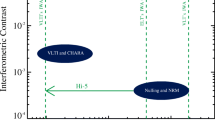Abstract
Extrasolar planets must be imaged directly if their nature is to be better understood. But this will be difficult, as the bright light from the parent star (or rather its diffracted halo in the imaging apparatus) can easily overwhelm nearby faint sources. Bracewell has proposed1 a way of selectively removing starlight before detection, by superposing the light from two telescopes so that the stellar wavefronts interfere destructively. Such a ‘nulling’ interferometer could be used in space to search for extrasolar Earth-like planets through their thermal emission and to determine through spectroscopic analysis if they possess the atmospheric signatures of life2,3,4. Here we report mid-infrared observations using two co-mounted telescopes of the Multiple Mirror Telescope that demonstrate the viability of this technique. Images of unresolved stars are seen to disappear almost completely, while light from a nearby source as close as 0.2 arcsec remains, as shown by images of Betelgeuse. With this star cancelled, there remains the thermal image of its surrounding, small dust nebula. In the future, larger ground-based interferometers that correct for atmospheric distortions (using adaptive optics) should achieve better cancellation, allowing direct detection of warm, Jupiter-size planets and faint zodiacal dust around other nearby stars5.




Similar content being viewed by others
References
Bracewell, R. N. Detecting nonsolar planets by spinning infrared interferometer. Nature 274, 780–781 (1978).
Angel, J. R. P., Cheng, A. F. & Woolf, N. J. Aspace telescope for infrared spectroscopy of earthlike planets. Nature 322, 341–343 (1986).
Leger, A. et al. Could we search for primitive life on extrasolar planets in the near future? Icarus 123, 249–255 (1996).
Woolf, N. J. & Angel, J. R. P. in Planets Beyond the Solar System and the Next Generation of Space Missions (ed. Soderblom, D.) 285–293 (ASP Conf. Ser 119, Astron. Soc. Pacific., Baltimore, 1997).
Angel, J. R. P. & Woolf, N. J. in Planets Beyond the Solar System and the Next Generation of Space Missions (ed. Soderblom, D.) 206–222 (Baltimore, 1997).
Angel, J. R. P. in The Next Generation Space Telescope (eds Bely, P. Y., Burrows, C. J. & Illingworth, G. D.) 81–94 (Space Telescope Science Institute, Baltimore, 1990).
Angel, J. R. P., Burge, J. H. & Woolf, N. J. Detection and spectroscopy of exo-planets like Earth. Proc. SPIE 2871, 516–519 (1996).
Danchi, W. C., Bester, M., Degiacomi, C. G., Greenhill, L. J. & Townes, C. H. Characteristics of dust shells around 13 late-type stars. Astron. J. 107, 1469–1513 (1994).
Hebden, J. C. et al. Two-dimensional images of alpha Orionis. Astrophys. J. 309, 745–754 (1987).
Gilliland, R. L. & Dupree, A. K. First images of the surface of a star with the Hubble Space Telescope. Astrophys. J. 463, L29–L32 (1996).
Lim, J., Carilli, C. L., White, S. M., Beasley, A. J. & Marson, R. G. Large convection cells as the source of Betelgeuse's extended atmosphere. Nature 392, 575–577 (1998).
Bester, M. et al. Measurement at 11 micron wavelengths of the diameter of α Orionis and α Scorpii, and changes in effective temperature of α Orionis and very recent dust emission. Astrophys. J. 463, 336–343 (1996).
Hinz, P. M. et al. First results of nulling interferometry with the Multiple Mirror Telescope. Proc. SPIE (in the press).
Noll, R. J. Zernike polynomial and atmospheric turbulence. J. Opt. Soc. Am. 66, 207–211 (1976).
Hill, J. M. & Salinari, P. Large Binocular Telescope project. Proc. SPIE (in the press).
Angel, J. R. P. & Woolf, N. J. An imaging nulling interferometer to study extra-solar planets. Astrophys. J. 475, 373–379 (1996).
Hoffmann, W. F., Hora, J. L., Fazio, G. G., Deutsch, L. K. & Dayal, A. MIRAC2, a mid-infrared camera for astronomy. Proc. SPIE (in the press).
Acknowledgements
We thank C. Foltz and the MMT staff for their essential support of the project. This work was supported by AFOSR, NASA and the US NSF.
Author information
Authors and Affiliations
Corresponding author
Rights and permissions
About this article
Cite this article
Hinz, P., Angel, J., Hoffmann, W. et al. Imaging circumstellar environments with a nulling interferometer. Nature 395, 251–253 (1998). https://doi.org/10.1038/26172
Received:
Accepted:
Issue Date:
DOI: https://doi.org/10.1038/26172
- Springer Nature Limited
This article is cited by
-
Scalable photonic-based nulling interferometry with the dispersed multi-baseline GLINT instrument
Nature Communications (2021)
-
The path towards high-contrast imaging with the VLTI: the Hi-5 project
Experimental Astronomy (2018)
-
Future Space Missions to Search for Terrestrial Planets
Space Science Reviews (2008)
-
Interferometric space missions for the search for terrestrial exoplanets: Requirements on the rejection ratio
Astrophysics and Space Science (2006)
-
Deep and stable interferometric nulling of broadband light with implications for observing planets around nearby stars
Nature (2000)





